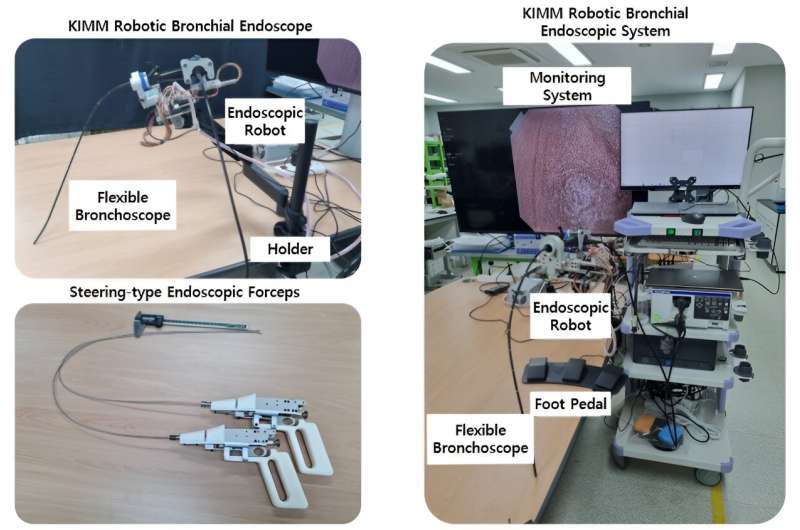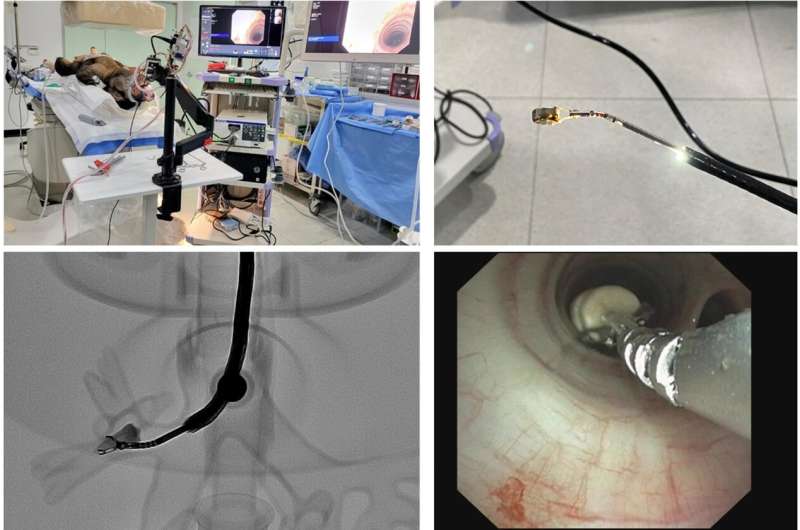This article has been reviewed according to Science X's editorial process and policies. Editors have highlighted the following attributes while ensuring the content's credibility:
fact-checked
trusted source
proofread
Researchers develop robotic bronchial endoscope system to resolve foreign substance inhalation accidents in children

A robotic bronchial endoscopic system has been engineered to reduce side effects and provide prompt intervention during emergencies involving airway blockages in infants, young children, or the elderly caused by food or foreign substances. This innovative system is expected to be highly beneficial in emergency scenarios, as it has the potential to decrease the requisite medical personnel needed to treat individuals with obstructed airways.
A research team led by Principal Researcher Ki-Young Kim of the Department of Medical Robotics of the Korea Institute of Machinery and Materials, an institute under the jurisdiction of the Ministry of Science and ICT, and Professor Jae-Won Chang of the department of otolaryngology of Chungnam National University Hospital has achieved a breakthrough with the creation of an advanced robotic bronchial endoscopic system.
This system features multidirectional endoscopic forceps, an ocular position tracking capability, and a foot pedal control. The joint research team successfully extracted a foreign substance from the bronchus during a clinical trial conducted on a miniature pig.
The endoscopic forceps are long and flexible enough to be inserted into the working channel of the endoscopic camera device. The ends of endoscopic forceps have the shape of a gripper and can be used for removing polyps. Endoscopic forceps are used mainly for examining small tissues or removing polyps of internal organs during endoscopy.
KIMM has innovated a robotic bronchial endoscope system, harnessing integrating technology from surgical robots that can adjust the direction of the camera and applying it to a flexible bronchoscope, a slender, pliable tube used in medical diagnostics and treatments.

A flexible bronchoscope is composed of a thin and bendable tube, with a small-sized camera and an LED light bulb at its tip. Easily controllable by the user, a flexible bronchoscope is used for performing diagnoses or treatments by being inserted into the bronchus.
This cutting-edge endoscopic system links the camera of the bronchoscope to the robotic apparatus, enabling medical personnel to precisely manipulate the robot's position by securing it to a multi-joint stand. The system also includes a versatile joint on the gripper of the endoscopic forceps, complemented by a wire that adjusts the direction of the joint, allowing for easy navigation and removal of foreign bodies from the desired location.
Additionally, the "drivable area estimation technology" developed by KIMM can be used to detect general obstacles as well as steep slopes, potholes, and bumpy roads and automatically identify alternative routes to avoid those obstacles, which can help to prevent the machinery or vehicle from colliding with other objects. Moreover, KIMM has also developed the "driving control technology" for controlling the driving of a vehicle on a real-time basis by selecting, among the various technologies described above, only the functions that are needed.
Furthermore, KIMM has incorporated eye position tracking technology that follows the movements of the medical staff's eyes, along with a foot pedal mechanism that allows direct control of the device. This integration empowers the endoscope to bend, move straight, and rotate to reach and remove the targeted obstruction.
The design advantageously reduces the number of medical staffs required for such procedures. Traditional endoscopic forceps lacked the ability to move horizontally and vertically due to the absence of bending joints. Moreover, the operation of bendable endoscopes typically necessitated an assistant since the medical staff's hands were occupied with the extraction task.
The novel technology enables multi-directional adjustments of the endoscope and reduces personnel involvement, which holds promise for enhancing the quality of medical services in the future.
Principal Researcher Ki-Young Kim of KIMM said, "We have adapted the technology from robotic laparoscopic surgeries for use in a smaller-diameter endoscopic forceps, breaking through the boundaries of existing surgical methods."
Senior Researcher Kim added, "Going forward, we will attempt to develop tinier endoscopic forceps for broader surgical applications, including outpatient procedures."
Professor Jae-Won Chang of the CNU Hospital, who supervised the preclinical test, said, "Compared to conventional surgical approaches, the new robotic endoscope system developed by KIMM has demonstrated its capability to remove foreign bodies while concurrently minimizing side effects."
Professor Chang added, "Now that we have verified the effectiveness of the system through the successful clinical trial on a miniature pig, we will make our outmost efforts to develop systems that can be applied to upper respiratory surgeries."





















